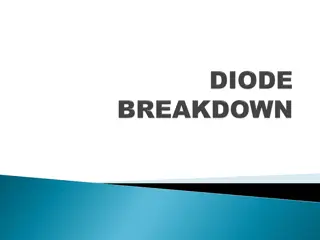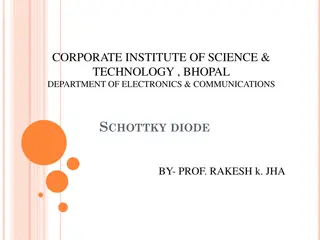Understanding P-N Junction and Semiconductor Physics
A p-n junction is a crucial interface in semiconductor devices that consists of a p-type and an n-type material, creating a boundary with distinctive charge carriers. By doping different semiconductor materials, a p-n junction can be formed, enabling the diffusion and drift of electrons and holes across the junction, leading to the generation of a built-in potential. The presence of depletion regions and drift currents influences the behavior of carriers in the semiconductor structure.
Download Presentation

Please find below an Image/Link to download the presentation.
The content on the website is provided AS IS for your information and personal use only. It may not be sold, licensed, or shared on other websites without obtaining consent from the author. Download presentation by click this link. If you encounter any issues during the download, it is possible that the publisher has removed the file from their server.
E N D
Presentation Transcript
Solid state physics Lecture (4) Prof. Dr. Wisam J. Aziz
P-N Junction A p-n junction is an interface or a boundary between two semiconductor material types, namely the p-type and the n- type, inside a semiconductor. The p-side or the positive side of the semiconductor has an excess of holes and the n-side or the negative side has an excess of electrons.
Formation of P-N Junction Doping : is the process of use different semiconductor materials to make a p-n junction, there will be a grain boundary that would inhibit the movement of electrons from one side to the other by scattering the electrons and holes. Example consider a thin p-type silicon semiconductor sheet when add a small amount of pentavalent impurity to this, a part of the p-type Si will get converted to n-type silicon. This sheet will now contain both p-type region and n- type region and a junction between these two regions.
Diffusion and Drift There is a difference in the concentration of holes and electrons at the two sides of a junction, the holes from the p-side diffuse to the n-side and the electrons from the n-side diffuse to the p- side. These give rise to a diffusion current across the junction.
When electrons and holes are diffusing from high concentration region to the low concentration region they both have a potential barrier. However, in drift case of minority carriers there is no potential barrier. Built in potential ; kT N N V = ln A n D bi 2 i q At fixed , is determined by the number of and atoms. T V N N bi A D
when an electron diffuses from the n-side to the p- side, an ionized donor is left behind on the n-side, which is immobile. As the process goes on, a layer of positive charge is developed on the n-side of the junction. Similarly, when a hole goes from the p-side to the n- side, and ionized acceptor is left behind in the p-side, resulting in the formation of a layer of negative charges in the p-side of the junction.
Depletion region: This region of positive charge and negative charge on either side of the junction. Drift: It is a motion of an electron on the p-side of the junction to the n-side of the junction due to the electric field. The direction of drift current is opposite to that of the diffusion current.
Biasing conditions for the p-n Junction There are three biasing conditions for p-n junction diode and this is based on the voltage applied: Zero bias: There is no external voltage applied to the p-n junction diode. Forward bias: The positive terminal of the voltage potential is connected to the p-type while the negative terminal is connected to the n-type. Reverse bias: The negative terminal of the voltage potential is connected to the p-type and the positive is connected to the n-type.
Forward Bias The p-type is connected to the positive terminal of the battery and the n-type to the negative terminal In the forward biased, the built-in electric field at the p-n junction and the applied electric field are in opposite directions. When both the electric fields add up the resultant electric magnitude lesser electric field. This results in a less resistive and thinner depletion region. field the has built-in a than
The depletion regions resistance becomes negligible when the applied voltage is large. In silicon, at the voltage of 0.6 V, the resistance of the depletion region becomes completely negligible and the current flows across it unimpeded.
The p-type is connected to the negative terminal of the battery and the n-type is connected to the positive side. In the reverse bias, the built-in electric field and the applied electric field are in the same direction. When the two fields are added, the resultant electric field is in the same direction as the built-in electric field creating a more resistive, thicker depletion region. The depletion region becomes more resistive and thicker if the applied voltage becomes larger.
P-N Junction Formula The formula used in the p-n junction depends upon the built-in potential difference created by the electric field is given as: E0is the zero bias junction voltage VTis the thermal voltage of 26mV at room temperature NDand NAare the impurity concentrations niis the intrinsic concentration.
How does current flow in P-N junction? The flow of electrons from the n-side towards the p- side of the junction takes place when there is an increase in the voltage. Similarly, the flow of holes from the p-side towards the n-side of the junction takes place along with the increase in the voltage. This results in the concentration gradient between both sides of the terminals.
Because of the formation of the concentration gradient, there will be a flow of charge carriers from higher concentration regions to lower concentration regions. The movement of charge carriers inside the p-n junction is the reason behind the current flow in the circuit.
I-V Characteristics of PN Junction I-V characteristics of PN junction is a curve between the voltage and current through the circuit. Voltage is taken along the x-axis while the current is taken along the y- axis. The above graph is the I-V characteristics curve of the PN junction. With the help of the curve it can understand that there are three regions in the Junction: Zero bias Forward bias Reverse bias
When the PN junction diode is under zero bias condition, there is no external voltage applied and this means that the potential barrier at the junction does not allow the flow of current. When the PN junction diode is under forward bias condition, the p-type is connected to the positive terminal while the n-type is connected to the negative terminal of the external voltage. When the diode is arranged in this manner, there is a reduction in the potential barrier. For silicone diodes, when the voltage is 0.7 V and for germanium diodes, when the voltage is 0.3 V, the potential barriers decreases and there is a flow of current.
When the diode is in forward bias, the current increases slowly and the curve obtained is non-linear as the voltage applied to the diode is overcoming the potential barrier. Once the potential barrier is overcome by the diode, the diode behaves normal and the curve rises sharply as the external voltage increases and the curve so obtained is linear. When the PN junction diode is under negative bias condition, the p-type is connected to the negative terminal while the n-type is connected to the positive terminal of the external voltage.
This results in an increase in the potential barrier. Reverse saturation current flows in the beginning as minority carriers are present in junction. When the applied voltage is increased, the minority charges will have increased kinetic energy which affects the majority charges. This is the stage when the diode breaks down. This may also destroy the diode.
Applications of PN Junction Diode p-n junction diode can be used as a photodiode as the diode is sensitive to the light when the configuration of the diode is reverse-biased. It can be used as a solar cell. When the diode is forward-biased, it can be used in LED lighting applications. It is used as rectifiers in many electric circuits and as a voltage- controlled oscillator.
Why are pn Junctions Important for ICs? - The basic building block in digital ICs is the MOS transistor, whose structure contains reverse- biased diodes. - p-n junctions are important for electrical isolation of transistors located next to each other at the surface of a Si wafer. - The junction capacitance of these diodes can limit the performance (operating speed) of digital circuits














